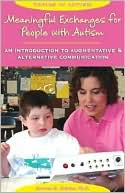List Books » Meaningful Exchanges for People with Autism: An Introduction to Augmentative and Alternative Communication
Category Books
- Fiction Books & Literature
- Graphic Novels
- Horror
- Mystery & Crime
- Poetry
- Romance Books
- Science Fiction & Fantasy
- Thrillers
- Westerns
- Ages 0-2
- Ages 3-5
- Ages 6-8
- Ages 9-12
- Teens
- Children's Books
- African Americans
- Antiques & Collectibles
- Art, Architecture & Photography
- Bibles & Bible Studies
- Biography
- Business Books
- Christianity
- Computer Books & Technology Books
- Cookbooks, Food & Wine
- Crafts & Hobbies Books
- Education & Teaching
- Engineering
- Entertainment
- Foreign Languages
- Game Books
- Gay & Lesbian
- Health Books, Diet & Fitness Books
- History
- Home & Garden
- Humor Books
- Judaism & Judaica
- Law
- Medical Books
- New Age & Spirituality
- Nonfiction
- Parenting & Family
- Pets
- Philosophy
- Political Books & Current Events Books
- Psychology & Psychotherapy
- Reference
- Religion Books
- Science & Nature
- Self Improvement
- Sex & Relationships
- Social Sciences
- Sports & Adventure
- Study Guides & Test Prep
- Travel
- True Crime
- Weddings
- Women's Studies
Meaningful Exchanges for People with Autism: An Introduction to Augmentative and Alternative Communication »

Authors: Joanne M. Cafiero
ISBN-13: 9781890627447, ISBN-10: 1890627445
Format: Paperback
Publisher: Woodbine House
Date Published: October 2005
Edition: (Non-applicable)
Author Biography: Joanne M. Cafiero
Book Synopsis
Many children and adults with autism spectrum disorders (ASDs) have great difficulty understanding and communicating with speech. As a result they can experience barriers to academic and social inclusion, and frustration when they cannot get their message across. A solution for many people with autism is augmentative & alternative communication (AAC), any system that utilizes tools, devices, symbols, pictures, words, or gestures to compensate for communication deficits.
Written by an experienced AAC consultant and teacher, Meaningful Exchanges for People with Autism provides an overview of AAC strategies and tools, from no-tech picture schedules to high-tech voice output communication aids. It also explains why AAC is such an effective and suitable communication option for people with ASDs. Throughout, there are real life vignettes of individuals using AAC, which vividly demonstrate how these strategies increase their communication and participation in the world around them. For parents, teachers, and practitioners looking for information on AAC, this book provides the perfect introduction.
Doody Review Services
Reviewer:Tamara Stone, MS, CCC-SLP(Communication Consultations)
Description:This book provides an introduction to augmentative communication to help improve the communicative functioning of individuals with autism.
Purpose:Joanne M. Cafiero has written a book to provide an overview of aided communication systems. It is written for parents and teachers as well specialists to be used as an additional reference for working with individuals needing or using augmentative and alternative communication (AAC) systems. This book has a place on the resource list of practitioners working with families of persons with autism who would like to discuss the use of AAC devices to facilitate and augment communication.
Audience:It is intended for families of persons who are using or who might benefit from AAC systems. It also provides an introduction to professionals about augmentative and alternative communication. The author uses vignettes to help in discussing the various types of AAC available for persons with autism.
Features:This book provides readers with information about no, low, and high tech AAC devices available on the market and how they might be used to benefit various individuals. In addition, it provides a primer on how assessment for AAC is conducted, how AAC devices are introduced to individuals, how these devices are adapted for a user, and how a user advances from one device to another. Also included is information on laws relating to AAC devices, additional sources of information regarding AAC, and sources for finding AAC systems. The book was written to be ready for print before IDEA 2004 had been adopted and does not provide the most updated information available regarding AAC devices and federal law. The author acknowledges this and offers sources through web sites and addresses in order to find the most current information regarding augmentative communication for individuals in the public school system.
Assessment:This will provide families with solid information to help them to be an active team member in the development and implementation of augmentative communication for persons with autism. The book should be added to the loan library of every practitioner working with AAC and individuals with autism. Practitioners wanting to gain some insight into this important aspect of serving individuals with impaired communication will find this an excellent introduction, with references to additional resources that will increase their knowledge base.
Table of Contents
| Introduction | 1 | |
| Chapter 1 | The Importance of Interactive Communication for People with ASD | 15 |
| Chapter 2 | ASD & AAC: The Perfect Fit | 25 |
| Chapter 3 | AAC Tools & Strategies | 35 |
| Chapter 4 | AAC Assessments: Identifying Communication Needs and the Tools to Address Them | 95 |
| Chapter 5 | AAC & the Law | 111 |
| Chapter 6 | Conclusion & Future Projections | 141 |
| References | 147 | |
| Resource Guide | 153 | |
| Glossary | 159 | |
| Index | 169 |
Subjects
 Diseases & Disorders
Diseases & Disorders  Psychological Disorders
Psychological DisordersParenting & Family
 Autism & Asperger's Syndrome
Autism & Asperger's Syndrome  Autism -> Popular works
Autism -> Popular worksParenting & Family
 Children with Special Needs
Children with Special Needs  Autism and Asperger's Syndrome - Popular works
Autism and Asperger's Syndrome - Popular worksSelf Improvement
 Psychological Self-Help
Psychological Self-Help  Psychological Self - Help - General & Miscellaneous
Psychological Self - Help - General & MiscellaneousSelf Improvement
 See All
See All  Self - Improvement
Self - Improvement
